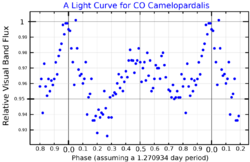Astronomy:HD 106112
| Observation data Equinox J2000.0]] (ICRS) | |
|---|---|
| Constellation | Camelopardalis |
| Right ascension | 12h 12m 11.94409s[2] |
| Declination | +77° 36′ 58.4696″[2] |
| Apparent magnitude (V) | 5.155[3] |
| Characteristics | |
| Spectral type | kA6hF0mF0 (III)[4] |
| U−B color index | +0.10[5] |
| B−V color index | +0.31[5] |
| Variable type | Ellipsoidal |
| Astrometry | |
| Radial velocity (Rv) | 0.40[6] km/s |
| Proper motion (μ) | RA: 11.40[2] mas/yr Dec.: 20.20[2] mas/yr |
| Parallax (π) | 29.96 ± 0.24[2] mas |
| Distance | 108.9 ± 0.9 ly (33.4 ± 0.3 pc) |
| Absolute magnitude (MV) | 1.62[7] |
| Orbit[6] | |
| Period (P) | 1.271 days |
| Eccentricity (e) | 0.01 |
| Periastron epoch (T) | 2436763.91 |
| Argument of periastron (ω) (secondary) | 163° |
| Semi-amplitude (K1) (primary) | 64.00 km/s |
| Details | |
| A | |
| Luminosity | 8.02[8] L☉ |
| Surface gravity (log g) | 3.98[9] cgs |
| Temperature | 7,122[9] K |
| Rotational velocity (v sin i) | 64.1[9] km/s |
| Other designations | |
| Database references | |
| SIMBAD | data |
HD 106112, also known as CO Camelopardalis, is a star in the constellation Camelopardalis. It has an apparent magnitude of about 5.1, meaning that it is just barely visible to the naked eye. Based upon parallax measurements made by the Hipparcos spacecraft, this star is around 177 light years away from the Sun.[2]
HD 106112's spectral type shows that it is an A-type giant star.[10] HD 106112 is also an Am star,[3] also known as a metallic-line star. These types of stars have spectra indicating varying amounts of metals, like iron.[11]
Observations of the stars spectrum reveal a periodic Doppler shift. This means that HD 106112 is a spectroscopic binary with a period of 1.271 days and an eccentricity of 0.01.[6] In fact, the two stars orbit so closely that they distort each other into an ellipsoidal shape through gravity, thereby forming a rotating ellipsoidal variable system. However, almost no information is known about the companion star.
References
- ↑ Steinbring, E.; Hube, D. P.; Martin, B. E. (April 1995). "The Ellipsoidal Variability of HR4646". Information Bulletin on Variable Stars 4184: 1. Bibcode: 1995IBVS.4184....1S. https://ui.adsabs.harvard.edu/abs/1995IBVS.4184....1S. Retrieved 9 November 2021.
- ↑ 2.0 2.1 2.2 2.3 2.4 2.5 van Leeuwen, F. (2007). "Validation of the new Hipparcos reduction". Astronomy and Astrophysics 474 (2): 653–664. doi:10.1051/0004-6361:20078357. Bibcode: 2007A&A...474..653V. http://www.aanda.org/index.php?option=com_article&access=bibcode&Itemid=129&bibcode=2007A%2526A...474..653VFUL.
- ↑ 3.0 3.1 3.2 "iot Del". SIMBAD. Centre de données astronomiques de Strasbourg. http://simbad.u-strasbg.fr/simbad/sim-basic?Ident=iot+Del.
- ↑ Gray, R. O.; Corbally, C. J.; Garrison, R. F.; McFadden, M. T.; Robinson, P. E. (2003). "Contributions to the Nearby Stars (NStars) Project: Spectroscopy of Stars Earlier than M0 within 40 Parsecs: The Northern Sample. I". The Astronomical Journal 126 (4): 2048. doi:10.1086/378365. Bibcode: 2003AJ....126.2048G.
- ↑ 5.0 5.1 Mermilliod, J.-C. (1986). "Compilation of Eggen's UBV data, transformed to UBV (unpublished)". Catalogue of Eggen's UBV Data. Bibcode: 1986EgUBV........0M. http://cdsads.u-strasbg.fr/cgi-bin/nph-bib_query?1986EgUBV........0M&db_key=AST&nosetcookie=1.
- ↑ 6.0 6.1 6.2 Pourbaix, D. et al. (2004). "SB9: The ninth catalogue of spectroscopic binary orbits". Astronomy and Astrophysics 424 (2): 727–732. doi:10.1051/0004-6361:20041213. Bibcode: 2004A&A...424..727P.
- ↑ Stateva, I.; Iliev, I. Kh.; Budaj, J. (2012). "Abundance analysis of Am binaries and search for tidally driven abundance anomalies - III. HD 116657, HD 138213, HD 155375, HD 159560, HD 196544 and HD 204188". Monthly Notices of the Royal Astronomical Society 420 (2): 1207–1216. doi:10.1111/j.1365-2966.2011.20108.x. Bibcode: 2012MNRAS.420.1207S.
- ↑ McDonald, I.; Zijlstra, A. A.; Boyer, M. L. (2012). "Fundamental parameters and infrared excesses of Hipparcos stars". Monthly Notices of the Royal Astronomical Society 427 (1): 343–357. doi:10.1111/j.1365-2966.2012.21873.x. Bibcode: 2012MNRAS.427..343M.
- ↑ 9.0 9.1 9.2 Schröder, C.; Reiners, Ansgar; Schmitt, Jürgen H. M. M. (January 2009), "Ca II HK emission in rapidly rotating stars. Evidence for an onset of the solar-type dynamo", Astronomy and Astrophysics 493 (3): 1099–1107, doi:10.1051/0004-6361:200810377, Bibcode: 2009A&A...493.1099S, http://goedoc.uni-goettingen.de/goescholar/bitstream/handle/1/9690/aa10377-08.pdf?sequence=2[yes|permanent dead link|dead link}}]
- ↑ Allen, J. S.. "The Classification of Stellar Spectra". http://www.star.ucl.ac.uk/~pac/spectral_classification.html.
- ↑ David Darling. "Am star, The Internet Encyclopedia of Science". http://www.daviddarling.info/encyclopedia/A/Am_star.html.
 |


